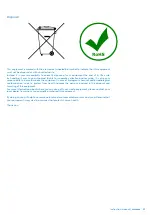
Instruction manual |
29
16. Troubleshooting
Review the information in the table below to troubleshoot operating problems.
Problem
Cause
Solution
I. Optical Section:
The illumination is on, but the field of view is dark.
The plug of the LED holder is not connected to the illumination
set
Connect them
The brightness is too low
Adjust to a proper setting
Too many colour filters have been stacked
Minimize the number of the filters
Fluorescence filter selector is not in a click stop
Move the selector to a click stop
Fluorescence filter is not suitable for the specimen
Use a suitable filter
The edge of the field of view is vignetted or the brightness is
asymmetric.
The nosepiece is not in the correct position
Turn the nosepiece to a click stop
The color filter is partially inserted
Insert the filter to full depth
The phase contrast slider is not in the proper position
Move the slider to a click stop
Dust and stains can be seen in the field of view.
There are stains and dust on the specimen
Clean the specimen
There are stains and dust on the eyepiece
Clean the eyepiece
Image looks double
The size of the aperture diaphragm is too small
Open the aperture diaphragm
Poor image quality:
–
The image is not sharp
–
The contrast is not high
–
The details are not clear
–
The phase contrast is low.
The nosepiece is not in the center of the light path
Turn the nosepiece to a click stop
The aperture diaphragm in the view of field is opened too much
or too little
Adjust the aperture diaphragm
The lenses (condenser, objective, eyepieces are culture dish) is
dirty
Thoroughly clean all the optical system
In phase contrast observation, the bottom thickness of the
sample is more than 1.2mm
Use a sample holder whose bottom thickness is 1,2mm
A bright field objective is used for phase contrast observation
Switch to a phase contrast objective
The condenser ring is not aligned with the objective phase ring Adjust the condenser ring to match the objective phase ring
The light ring and/or the phase contrast ring is not centered
Adjust the bolts to center them
The objective used is not compatible with the phase ring
Please use a compatible objective
The phase contrast depends on the sample position
The sample holder is not flat. Move the sample around until a
compatible area is found.
One side of the image is out of focus.
The nosepiece is not in the center of the light path
Turn the nosepiece to a click stop
The specimen is out of place (tilted)
Place the specimen flat on the stage
II. Mechanical Section:
The coarse focus knob is hard to turn.
The tension adjustment collar is too tight
Loosen the tension adjustment collar
The focus is unstable.
The tension adjustment collar is too loose
Tighten the tension adjustment collar
III. Electric section
The LED doesn’t turn on.
No power supply
Check the power cord connection
The brightness is not enough
The brightness adjustment is low
Adjust the brightness
The light blinks
The power cord is poorly connected
Check the power cord
IV. Observation tube
The field of view of the two eyes is different
The interpupillar distance is not correct
Adjust the interpupillar distance
The dioptric correction is not right
Adjust the dioptric correction
The viewing technique is not correct, and the operator is
straining the eyesight
When look into the objective, do not stare at the specimen but
look at the whole field of view. Periodically, move the eyes away
to look at a distant object, then back into the objective
V. Microphotography and video
The image is unfocused
Incorrect focussing
Adjusting the focus system as in the present manual
The edge of the image is unfocussed
To some degree, it is inherent to the nature of achromatic
objectives
The problem can be minimized by a correct setting of the
aperture diaphragm
Bright patches appear on the image
Stray light is entering the microscope through the eyepieces
and through the camera viewfinder
Cover the eyepieces and the viewfinder with a dark cloth




































